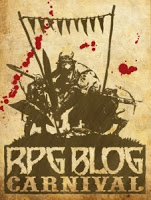In that spirit, and in the spirit of the RPG Blog Carnival theme Campaigns I'd Like To Run, here's a list of some of the RPGs out there that I'd love to "give chance" to -- primarily because even if I'd get a chance to run these games, the niched nature of these would make the players agreeing to it a long shot! But I'd really like to try out these particular systems or settings, because the interest me in particular.
EABA by BTRC
EABA is one of those Universal Roleplaying Systems that can handle multiple genres. It has game system elements similar to the DC Heroes / MEGS exponential scale table and the D6 system. And it's got a number of interesting settings to its name.
The setting I'd like to try is Verne, which is a Victorian Steampunk & Science Fiction setting (as you may have surmised from the title). Here's a bit of the blurb:
Battle dirigibles, Cavorite, steamtroops, dinosaurs, Martians, Selenites, mad scientists, clacking Babbage engines, the works. Verne starts off with the historical Victorian Era and then merges it with the fiction of Jules Verne, H.G.Wells, Edgar Rice Burroughs and others to create a seamless alternate history that the adventurers get to shape and be part of. Verne can be as stiff-upper-lip fictional or Victorian Era grimy as you like, with detailed historical and cultural information, half a dozen adventures and numerous plot-centered NPC's and gadgets.
Verne is nearly 220 pages of steampunk with the traditional BTRC attention to detail. Also available for Verne: A free interactive character creator for Verne, and a map pack with nearly 20 adventure locations, including an annotated interactive map of London.Oh yes, it should be fun!

 Traveller Hero
Traveller HeroYeah, these two books are out of print, but I'd still like to get my hand on a second-hand copy of both books and run them using the HERO System. It's the system I'm most comfortable with for modern and future settings, to be honest. One of my favorite SF campaigns was a Star Hero campaign, so Traveller with HERO is a logical leap. Boy, was I bummed when I found it it'd gone out of print (the license had been revoked) and I hadn't been able to buy it!
Pathfinder + NeoExodus: A House Divided
The setting is interesting enough for me to pick up Pathfinder, which I wouldn't normally do due to my allergy to the escalation of Feats that annoyed me about D&D 3.5. But with the OSR house rules and other things I've learned, I'm willing to make a streamlined run of the game to explore this interesting melange of concepts.
I did an Armchair Review of this particular book. Check out the link for more information on NeoExodus.







_2013)_Main_cast.JPG)

